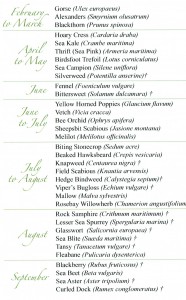Stokes Bay is a wonderful place to visit if you enjoy the beauty of our wild flowers. It is one of the few remaining unspoilt areas of coastline in Hampshire. A wide variety of wild flowers thrive here, from the western Browndown Ranges to the eastern Gilkicker (Lagoon) Lake. Coastal sedges can be found along the Gilkicker shoreline, such as Sheepsbit, Pale Flax, Toadflax, Carline Thistle and Hare’s Tail Grass. Sea Kale is rare elsewhere but can be found in abundance at Stokes Bay. The Browndown end of the Bay provides a habitat for Burnett Rose, Slender-Flowered Thistle and Nottingham Catchfly. Because of rare plants and creatures we are lucky to have two areas that have been designated as Sites of Special Scientific Interest by English Nature, Browndown and Gilkicker Lagoon
Our wild flowers gallery, month by month is here:
Wild Flowers Gallery
The following are just some of the flowers that can be found along the Bay if you look hard enough. The drawings and text are extracted from a beautifully illustrated book by Friends of Stokes Bay members Felicity Anderson and Wendy Osborne. It can be bought from the Friends, details are on our Publications Page.
Treasures of Stokes Bay : Wild Flowers

Left is the contents page of the booklet listing some of the plants that may be found at Stokes Bay:
For details of how to purchase a copy please visit our Publications Page.






























